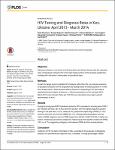HIV Testing and Diagnosis Rates in Kiev, Ukraine: April 2013 - March 2014
Kücherer, Claudia
Simmons, Ruth
Bartmeyer, Barbara
Malyuta, Ruslan
Chentsova, Nelli
Medoeva, Antonia
Kruglov, Yuri
Yurchenko, Alexander
Copas, Andrew
Porter, Kholoud
Hamouda, Osamah
Objective: Data from Ukraine on risk factors for HIV acquisition are limited. We describe the characteristics of individuals testing for HIV in the main testing centres of the Ukrainian capital Kiev, including HIV risk factors, testing rates, and positivity rates. Methods: As part of a larger study to estimate HIV incidence within Kiev City, we included questions on possible risk factors for HIV acquisition and testing history to existing systems in 4 infectious disease clinics. Data were provided by the person requesting an HIV test using a handheld electronic tablet. All persons (≥16yrs) presenting for an HIV test April 2013–March 2014 were included. Rates per 100,000 were calculated using region-specific denominators for Kiev. Results: During the study period 6370 individuals tested for HIV, equivalent to a testing rate of 293.2 per 100,000. Of these, 467 (7.8%) were HIV-positive, with the highest proportion positive among 31–35 year olds (11.2%), males (9.4%), people who inject drugs (PWID) (17.9%) and men who have sex with men (MSM) (24.1%). Using published population size estimates of MSM, diagnosis rates for MSM ranged from 490.6to 1548.3/100,000. A higher proportion of heterosexual women compared to heterosexual men reported contact with PWID, (16% vs. 4.7%) suggesting a bridging in risk between PWID and their sexual partners. Conclusion: Collection of HIV risk factor information in Kiev, essential for the purposes of developing effective HIV prevention and response tools, is feasible. The high percentage of MSM among those testing positive for HIV, may indicate a significant level of undisclosed sex between men in national figures.
Dateien zu dieser Publikation
Keine Lizenzangabe

